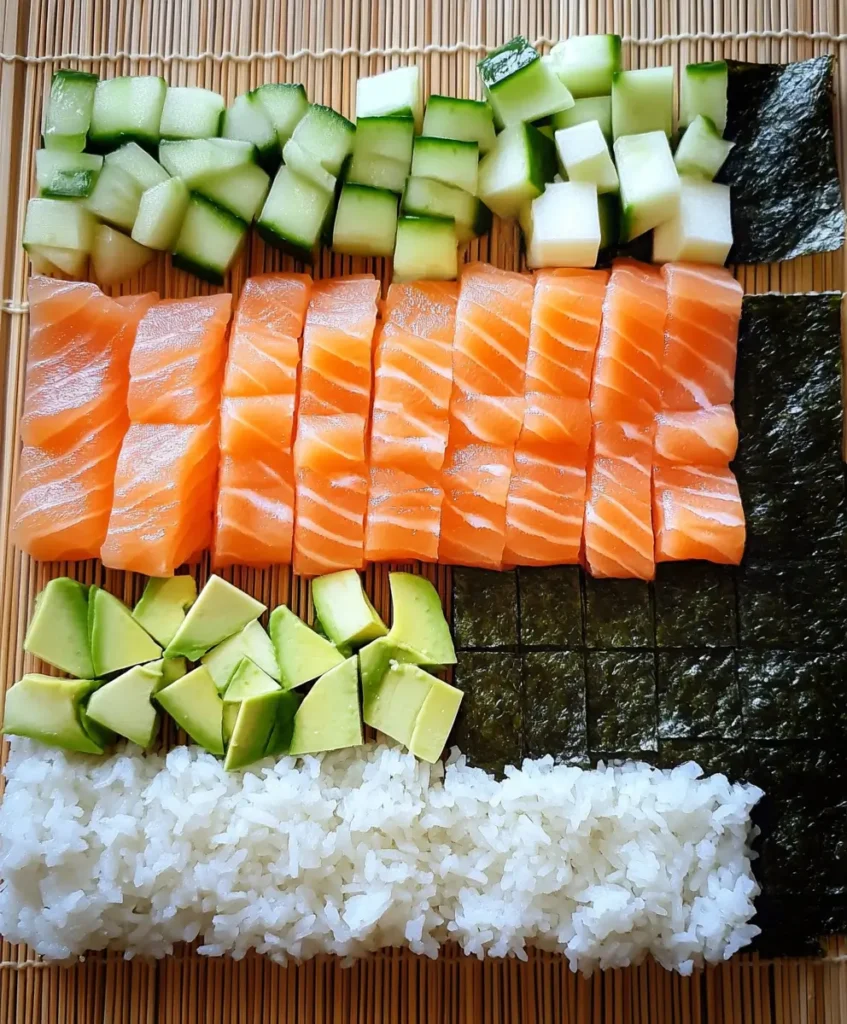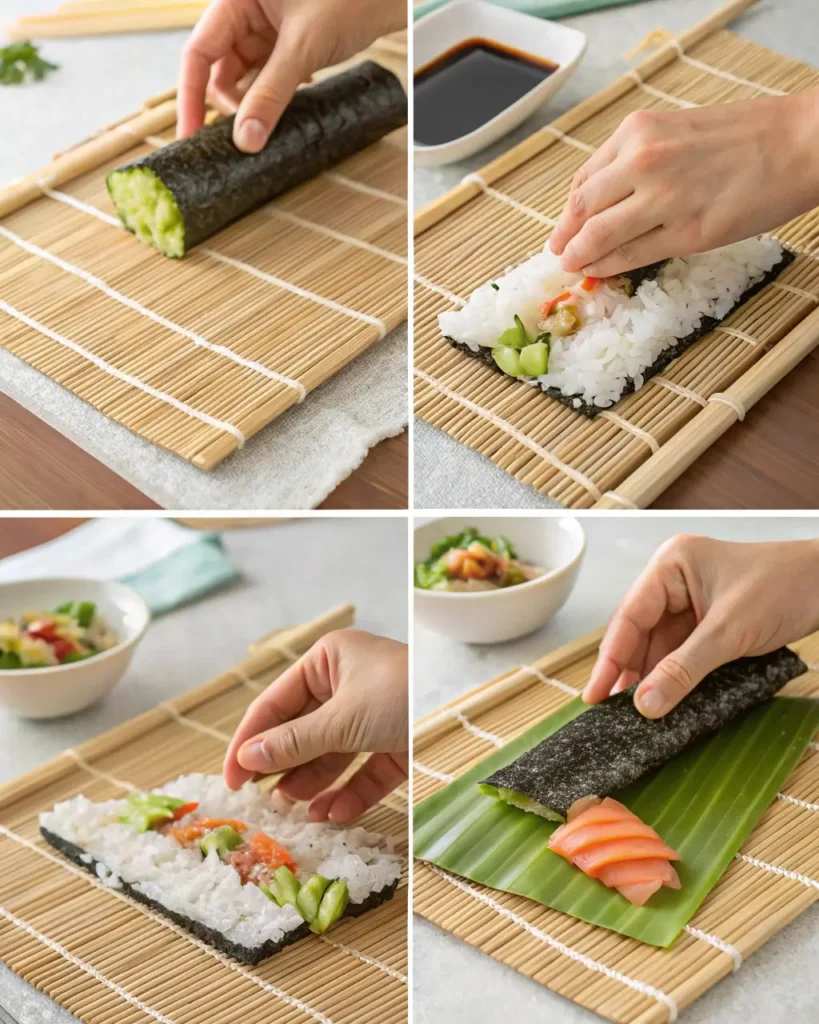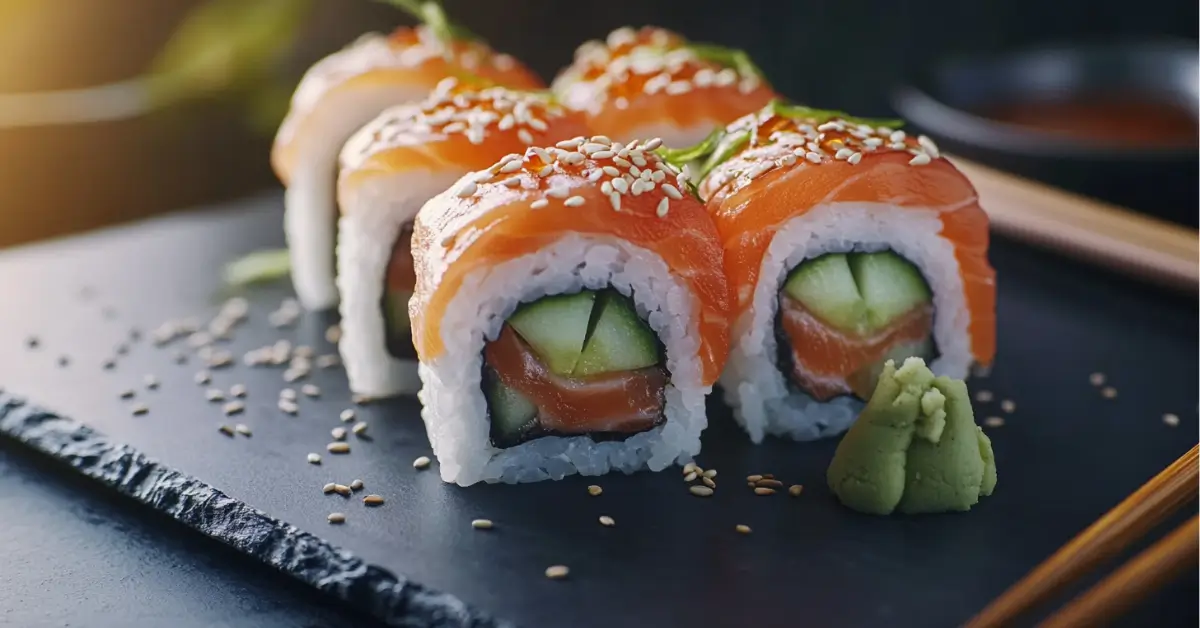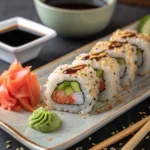Sushi fans across the U.S. are no strangers to the vibrant, mouthwatering Alaska roll. Often spotted on menus right beside familiar favorites like the California or Philadelphia roll, the Alaska roll brings its own twist to the sushi scene. But what exactly is an Alaska roll? How did it become a sushi staple in American restaurants, and how does it stack up nutritionally?
In this article, we’re diving deep into the Alaska roll — from its delicious ingredients to how it compares with other popular rolls. You’ll also find step-by-step prep tips, serving ideas, and answers to your top questions. Discover great ideas like the Southern Salmon Patties Recipe if you’re a seafood lover looking to explore more!
Jumo to:
What Is an Alaska Roll?
Origin and Evolution of the Alaska Roll
While traditional sushi has centuries-old roots in Japan, the Alaska roll is a modern creation that evolved outside of Japan, specifically crafted for Western palates. It was born out of the American sushi boom in the 1970s and ’80s when chefs began adapting traditional techniques with local ingredients.
The name “Alaska roll” pays homage to the use of fresh or smoked Alaskan salmon—a key ingredient that separates this roll from others. Inspired by regional flavors and the popularity of fusion cuisine, it blends classic sushi with a bit of bold American flair.
Over the years, sushi chefs have customized the Alaska roll to include different fillings, toppings, and presentations, depending on their locale and audience. Still, the base idea has remained the same: a rich, flavorful roll that features the beloved taste of salmon.
Why It’s a Popular Choice at Sushi Bars
The Alaska roll holds its own on sushi menus thanks to its balanced texture and flavor. Creamy avocado, crunchy cucumber, and savory salmon come together with vinegared rice and seaweed for a bite that’s both comforting and fresh.
It’s also one of the more approachable rolls for sushi beginners. Unlike some traditional sushi that might include raw fish or more complex flavors, the Alaska roll often comes with smoked salmon, making it feel familiar. Plus, its similarity to the Philadelphia roll adds a creamy touch, especially when cream cheese is included.
For those trying sushi for the first time, or simply looking for something that’s a little bold but still safe, the Alaska roll is often a go-to.
Alaska Roll Ingredients Explained
What Is Inside an Alaska Roll?
At its core, the Alaska roll is a fusion-style maki roll known for combining clean, fresh flavors with creamy, smooth textures. While recipes may vary depending on the sushi chef or region, the classic Alaska roll typically includes the following ingredients:
| Ingredient | Role in the Roll |
|---|---|
| Salmon | Usually smoked or fresh (sometimes raw) |
| Avocado | Adds creamy texture and healthy fats |
| Cucumber | Provides crunch and freshness |
| Sushi rice | Seasoned with vinegar, sugar, and salt |
| Nori (seaweed) | Used to wrap the roll |
| Sesame seeds | Often sprinkled on top for nuttiness |
| Optional: Cream cheese | Added for a richer, Philly-roll-style flavor |
The focus keyword “what is an Alaska roll” ties back to this delicious blend. It’s essentially a type of inside-out sushi roll (uramaki) — meaning the rice is on the outside, and the nori holds the filling on the inside.
Some Alaska rolls are topped with thin slices of raw salmon, while others are finished with a drizzle of spicy mayo, eel sauce, or even tobiko (flying fish roe) for a pop of color and texture.
Variations: Cooked vs. Raw Salmon Toppings
One of the most talked-about variations of the Alaska roll is whether the salmon is raw, smoked, or cooked. Here’s how each version differs:
- Smoked Salmon Alaska Roll: This is the most common version served in U.S. sushi bars. It offers a mild smoky flavor, is easier for sushi beginners, and is safer for those wary of raw fish.
- Raw Salmon Alaska Roll: A more traditional sushi experience for purists, raw salmon has a melt-in-your-mouth texture and a clean, oceanic taste.
- Cooked Salmon Alaska Roll: Some recipes use baked or grilled salmon, often marinated or spiced beforehand. This version is more hearty and leans toward fusion cuisine.
Whether you’re enjoying it at a sushi restaurant or making it at home, the Alaska roll offers a ton of room for customization based on taste and dietary needs.
Looking for inspiration? Try our Baked Flounder recipe if you’re in the mood for more seafood favorites.

Alaska Roll vs. Philadelphia Roll
Key Differences in Ingredients and Flavor
The Alaska roll and the Philadelphia roll often get confused — and for good reason. Both feature salmon and often include creamy ingredients. But the two rolls have distinct differences in flavor, texture, and presentation.
Here’s a side-by-side breakdown:
| Feature | Alaska Roll | Philadelphia Roll |
|---|---|---|
| Main Protein | Smoked or raw salmon | Smoked salmon |
| Cream Cheese | Optional | Always included |
| Other Fillings | Avocado, cucumber | Avocado, cucumber, sometimes scallions |
| Top Layer | Sometimes topped with raw salmon | Usually not topped |
| Texture | Light and fresh | Creamy and rich |
| Flavor Profile | Balanced and clean | Bold and savory |
One key distinction is cream cheese—which is a must-have in a Philly roll but optional in an Alaska roll. That one ingredient dramatically changes the taste and mouthfeel, making the Philadelphia roll heavier and more indulgent, while the Alaska roll stays lighter and fresher.
So if you’re craving something fresh with a little bite, the Alaska roll is your friend. But if you’re in the mood for rich, creamy goodness, the Philadelphia roll may be more up your alley.
Regional Preferences and Presentation
Another difference lies in how sushi restaurants present these rolls. In many East Coast and Midwest U.S. cities, the Alaska roll is topped with raw salmon sashimi, giving it a beautiful, colorful appearance that sushi fans love to photograph.
Meanwhile, the Philadelphia roll often sticks to a basic uramaki layout, with the rice outside and a simple interior mix. It’s not as flashy but hits hard on flavor.
Some sushi bars even merge the two rolls, offering “Alaska Philly Rolls” — combining the best of both worlds with salmon on top and cream cheese inside.
Don’t miss our Air Fryer Pancakes if you’re planning a fusion-themed brunch with sushi and sweet treats!
Is the Alaska Roll a Healthy Choice?
Nutritional Breakdown of Common Ingredients
When you hear the word “sushi,” you might instantly think “healthy.” And in many ways, sushi can be a nutritious meal, especially when it’s packed with lean proteins, healthy fats, and fresh veggies — like in the Alaska roll.
Let’s break down the estimated nutritional values for a standard 6-8 piece Alaska roll:
| Nutrient | Approx. Value per Roll |
|---|---|
| Calories | 300–400 kcal |
| Protein | 12–18g |
| Carbohydrates | 35–45g |
| Fat | 10–15g |
| Sodium | 400–600mg |
Here’s where the Alaska roll shines:
- Salmon is high in Omega-3 fatty acids, known to reduce inflammation and support heart and brain health.
- Avocado brings in potassium, fiber, and healthy monounsaturated fats.
- Cucumber adds crunch and hydration with minimal calories.
But it’s not all seaweed and sunshine. Sushi rice is often seasoned with sugar and salt, which can increase calorie and sodium content. Also, if the roll is topped with sauces like spicy mayo or eel sauce, calories and fats can spike quickly.
Calories, Fats, and Healthier Modifications
If you’re watching your calorie intake or trying to eat lighter meals, the Alaska roll is still a great middle-ground sushi option — especially when compared to tempura or cream cheese-heavy rolls.
Here are a few easy tweaks to make your Alaska roll healthier:
| Healthy Tip | Benefit |
|---|---|
| Ask for less rice | Cuts carbs and calories |
| Skip the sauce or get it on the side | Reduces saturated fats and sugars |
| Choose raw salmon instead of smoked | Lowers sodium |
| Add extra cucumber or avocado | Boosts fiber and volume |
| Go for brown rice if available | Adds whole grains |
In general, the Alaska roll offers a satisfying mix of flavors without going overboard on calories, making it a solid choice for health-conscious eaters.
Check out our Naturally Sweet Granola Bars for a delicious and energizing snack to pair with your sushi lunch or dinner!
California Roll vs. Alaska Roll
What Makes Them Similar?
If you’ve browsed a sushi menu in the U.S., chances are you’ve seen both California rolls and Alaska rolls listed near the top. These two popular rolls are often grouped together for good reason: they’re both Westernized sushi creations made with accessible, beginner-friendly ingredients.
Here’s what they have in common:
- Avocado and cucumber are standard in both.
- Both are inside-out rolls (uramaki), where the rice is on the outside.
- They avoid raw fish in many versions, appealing to those hesitant about traditional sushi.
- Often topped or garnished with sesame seeds, spicy mayo, or tobiko for flair.
These rolls helped introduce sushi to American audiences by using ingredients that were both tasty and less intimidating than raw fish.
What Is a California Roll with Salmon Called?
Here’s where things get interesting. If you take a California roll (usually filled with imitation crab, cucumber, and avocado) and add slices of raw or smoked salmon on top, you’re essentially turning it into an Alaska roll.
But technically, some chefs call this a “Salmon California Roll” or even a “Deluxe California Roll.” Others keep it under the Alaska roll umbrella as long as salmon is involved. So the name can vary by region and restaurant.
Still, the defining factor is simple:
- If the roll includes salmon + avocado + cucumber, with or without cream cheese, it’s leaning toward an Alaska roll.
- If it contains imitation crab (or real crab) and the salmon is added on top, it’s more of a hybrid roll.
Ultimately, both rolls are delicious, but the Alaska roll brings more protein and a fresher, cleaner taste, especially when topped with raw salmon.
Don’t miss our Delicious Donut Holes for a fun dessert pairing after your sushi night!
Traditional Sushi Rolls vs. Modern Fusion Rolls
The 5 Most Traditional Sushi Rolls Explained
Before rolls like the Alaska roll and California roll took over Western sushi menus, sushi in Japan had a very different look and taste. Traditional sushi emphasizes minimal ingredients, fresh seafood, and careful balance of umami, sourness, and texture.
Here are five of the most classic sushi rolls (makizushi) you’ll find in authentic Japanese cuisine:
| Traditional Roll | Key Ingredients |
|---|---|
| Tekka Maki | Tuna, rice, nori |
| Kappa Maki | Cucumber, rice, nori |
| Shinko Maki | Pickled radish, rice, nori |
| Futomaki | Egg, pickled vegetables, spinach, etc. |
| Negitoro Maki | Fatty tuna and scallions |
These rolls focus on simplicity, texture, and seasonal ingredients. You won’t find cream cheese, spicy mayo, or fried toppings in traditional rolls — they’re all about subtlety and balance.
How the Alaska Roll Fits into Modern Sushi Culture
The Alaska roll, like many fusion creations, was born from the idea of adapting sushi to Western palates. Sushi chefs in North America began experimenting with:
- Substituting local ingredients (like Alaskan salmon instead of Japanese fish)
- Adding creamy elements like avocado and cream cheese
- Creating inside-out rolls to appeal to visual preferences
In that sense, the Alaska roll represents the evolution of sushi from a strictly Japanese art form to a global culinary trend. It’s:
- More colorful and dramatic in appearance
- Often more filling due to added fats (cream cheese, sauces)
- Designed to appeal to new sushi lovers and kids
While it’s far from traditional, the Alaska roll has carved out its place in modern sushi fusion, becoming a gateway for curious eaters.
Learn more about fusion seafood ideas like our Southern Salmon Patties that blend classic techniques with bold flavor.
Making an Alaska Roll at Home
Essential Tools and Ingredients You’ll Need
Making sushi at home may seem intimidating, but the Alaska roll is actually a great place to start. It’s simple, forgiving, and doesn’t require raw fish if you use smoked salmon. Here’s what you’ll need to get started.
Basic Tools:
- Bamboo sushi rolling mat (makisu)
- Plastic wrap (to prevent rice sticking to the mat)
- Sharp knife (non-serrated, ideally wet to prevent sticking)
- Cutting board
- Small bowl of water (for handling sticky rice)
Ingredients:
| Ingredient | Notes |
|---|---|
| Sushi rice | Short-grain, seasoned with rice vinegar, sugar, salt |
| Nori sheets | Dried seaweed, cut in half for smaller rolls |
| Smoked or raw salmon | Thin slices, chilled |
| Avocado | Ripe but firm, sliced |
| Cucumber | Julienned, peeled if desired |
| Sesame seeds | Optional, for rolling the rice side |
| Optional: Cream cheese | If you want a Philly-style Alaska roll |
Pro Tip: You can swap smoked salmon for raw sashimi-grade salmon, or even cooked salmon flakes for a safer option.
Step-by-Step Preparation Guide
Here’s how to assemble your homemade Alaska roll like a pro:
1. Cook and Season the Rice
Rinse 1 cup of sushi rice thoroughly. Cook according to package directions. While warm, mix in a blend of rice vinegar (2 tbsp), sugar (1 tbsp), and salt (1 tsp). Let cool to room temperature.
2. Prepare the Fillings
Slice the avocado and cucumber into thin, even strips. If using cream cheese, cut it into long strips. Cut the salmon into thin sashimi-style pieces if using raw, or flake it if cooked.
3. Wrap the Mat
Lay plastic wrap over the bamboo mat. Place a half sheet of nori shiny side down.
4. Add the Rice
With wet hands, press a thin layer of sushi rice evenly over the nori. Sprinkle sesame seeds if desired. Flip it over so the rice is on the outside.
5. Add Fillings
On the bottom third of the nori, line up your avocado, cucumber, salmon, and optional cream cheese.
6. Roll It Up
Use the mat to tightly roll the sushi away from you, forming a cylinder. Apply gentle pressure as you go to keep it tight.
7. Slice and Serve
Using a wet, sharp knife, cut the roll into 6-8 even pieces. Wipe the blade between cuts for clean slices.
8. Garnish
Top with extra salmon slices, spicy mayo, or tobiko if desired. Serve with soy sauce, pickled ginger, and wasabi.

Don’t miss our Air Fryer Pancakes recipe if you’re making sushi brunch and want a sweet pairing to finish it off!
Tips for Ordering Sushi Like a Pro
Understanding the Menu: Rolls, Nigiri, and Sashimi
When you’re at a sushi restaurant — whether it’s your first time or your hundredth — understanding the layout of the menu can help you make better choices, especially if you’re looking for rolls like the Alaska roll.
Here’s a quick cheat sheet for types of sushi you’ll see:
| Type of Sushi | Description |
|---|---|
| Maki | Rolled sushi, often with seaweed on the outside |
| Uramaki | Inside-out roll (rice on the outside, like Alaska roll) |
| Nigiri | A slice of fish over a small bed of rice |
| Sashimi | Sliced raw fish, no rice |
| Temaki | Hand rolls, cone-shaped with nori on the outside |
Since the Alaska roll is a type of uramaki, it will typically be listed under the “Specialty Rolls” or “House Rolls” section. It may also be named something different depending on the restaurant — look for keywords like “salmon,” “avocado,” or “smoked salmon” in the description.
When to Choose an Alaska Roll at a Sushi Restaurant
So when should you opt for the Alaska roll? Here’s when it’s a smart (and tasty) choice:
- You’re new to sushi: The Alaska roll’s familiar ingredients (smoked salmon, avocado, cucumber) make it ideal for beginners.
- You’re looking for something healthier: It’s generally lighter than fried or cream cheese-heavy rolls.
- You’re not into raw fish: Smoked or cooked salmon is commonly used, making it a great option for cautious eaters.
- You want fresh flavor: With clean, bright ingredients, the Alaska roll offers a refreshing bite every time.
Pro Ordering Tips:
- Ask what type of salmon is used — some places offer raw, others smoked, and some even give you a choice.
- If you’re avoiding carbs, ask if they offer a no-rice version or can substitute with cucumber wrap.
- Want to splurge a bit? Ask to add spicy mayo or tobiko on top for extra texture and heat.
Pairings and Serving Ideas
Best Sides and Sauces for an Alaska Roll
Pairing your Alaska roll with the right sides and sauces can take your sushi night from good to unforgettable. Whether you’re preparing it at home or ordering out, these additions complement the flavors and textures of the Alaska roll beautifully.
Sauces to Try:
- Soy Sauce: A classic, light dip for subtle saltiness.
- Spicy Mayo: Adds a creamy, spicy kick that pairs well with salmon and avocado.
- Ponzu Sauce: A citrusy soy-based sauce that enhances freshness.
- Eel Sauce (Unagi): Sweet and thick, great for a savory depth.
Sides to Serve:
| Side Dish | Flavor Contribution |
|---|---|
| Miso Soup | Warm and savory, balances cold sushi |
| Seaweed Salad | Crunchy, tangy, and nutrient-rich |
| Edamame | Salty and satisfying, perfect finger food |
| Pickled Ginger | Cleanses the palate between bites |
| Wasabi | Adds heat and depth |
Combining these sauces and sides allows each bite of Alaska roll to shine in contrast — creating a dynamic eating experience.
Presentation Tips for a Sushi Night at Home
When serving Alaska rolls at home, presentation adds to the experience — even more so if you’re hosting guests.
Here’s how to plate it like a sushi chef:
- Slice each roll cleanly using a sharp, damp knife.
- Arrange in a fan or circle formation on a ceramic or slate plate.
- Garnish with a side of pickled ginger, wasabi, and a small dipping bowl of soy or ponzu.
- Add a sprinkle of sesame seeds or green onions on top for color.
- Serve with small individual chopstick sets and chilled sake or green tea.

Looking for inspiration? Try our Naturally Sweet Healthy Granola Bars for a nutritious snack or dessert pairing after your Alaska roll dinner.
Frequently Asked Questions About the Alaska Roll
What is Alaska roll made of?
An Alaska roll typically contains smoked or raw salmon, avocado, and cucumber, all wrapped in seasoned sushi rice and nori (seaweed). Some versions include cream cheese, and many are topped with slices of salmon or drizzled with spicy mayo or eel sauce. It’s a flexible, fusion-style roll that often varies slightly by restaurant.
What is the difference between a Philadelphia roll and an Alaska roll?
While both rolls often feature salmon and avocado, the key difference is cream cheese — it’s a staple in the Philadelphia roll but optional in the Alaska roll. Additionally, the Alaska roll may be topped with raw salmon and leans toward a lighter, fresher taste, while the Philly roll is creamier and richer.
Is Alaska roll healthy?
Yes, the Alaska roll can be a healthy sushi choice. It’s packed with omega-3-rich salmon, fiber from avocado and cucumber, and lean carbohydrates from sushi rice. To keep it healthier, opt for minimal sauce, request less rice, or ask for raw salmon instead of smoked to reduce sodium.
What is a California roll with salmon on top called?
When a California roll is topped with raw or smoked salmon, it’s often referred to as a “Salmon California Roll” or simply an Alaska roll, depending on the restaurant. The addition of salmon on top gives it the bright, fresh profile associated with Alaska-style sushi rolls.
What are the five traditional sushi rolls?
Five traditional sushi rolls (makizushi) include:
Tekka Maki – tuna roll
Kappa Maki – cucumber roll
Shinko Maki – pickled radish roll
Futomaki – a thicker roll with mixed vegetables and egg
Negitoro Maki – fatty tuna with scallions
These are minimalist and focused on fresh ingredients, unlike fusion rolls like the Alaska roll.
What does the Boston roll have in it?
A Boston roll usually features cooked shrimp (often poached), avocado, and cucumber, wrapped in rice and seaweed. It may also include lettuce or other greens and is often topped with masago (fish roe) or sesame seeds. It’s another beginner-friendly, American-style sushi roll.
Conclusion: So, What Is an Alaska Roll Really?
The Alaska roll is more than just another item on your favorite sushi menu — it’s a delicious example of how traditional Japanese techniques blend with American flavors to create something entirely unique. With its balance of fresh salmon, creamy avocado, and crunchy cucumber, it’s a sushi roll that delivers on both flavor and texture.
Whether you’re a sushi newbie or a seasoned eater, the Alaska roll checks all the boxes: it’s versatile, satisfying, and easy to customize. You now know how it compares to other popular rolls, how to make it at home, and how to order it like a pro.
So next time you’re at a sushi restaurant — or rolling up your sleeves in your kitchen — give the Alaska roll a try. It’s a perfect blend of fresh and fusion, rolled into one bite-sized experience.
Discover more unique fusion meals like our Southern Salmon Patties and keep elevating your seafood game!
PrintWhat Is an Alaska Roll? A Deep Dive into This Popular Sushi Delight
- Prep Time: 25 minutes
- Total Time: 25 minutes
- Yield: 2 Rolls (12–16 pieces)
- Category: Seafood
- Cuisine: Japanese-American Fusion
Ingredients
Sushi rice,
nori sheets, smoked/raw salmon,
avocado,
cucumber,
optional cream cheese
Instructions
Prepare rice, slice fillings, assemble with sushi mat, roll tightly, slice, serve with soy sauce and wasabi
Notes
Nutrition (per roll): ~360 kcal, 15g protein, 40g carbs, 12g fat


